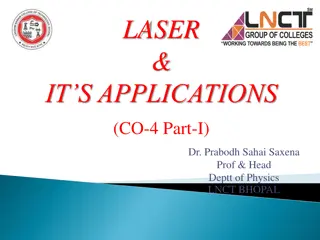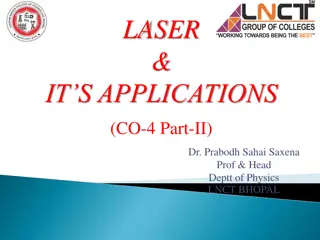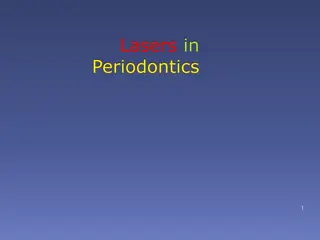Understanding the Principle and Working of Semiconductor Lasers
Semiconductor lasers operate through absorption, spontaneous emission, and stimulated emission processes. Absorption of radiation causes electrons to jump to higher energy levels, leading to light emission. Spontaneous emission is when excited electrons return to ground state by emitting photons, while stimulated emission involves photons interacting with excited electrons to emit more photons, resulting in laser production.
Download Presentation

Please find below an Image/Link to download the presentation.
The content on the website is provided AS IS for your information and personal use only. It may not be sold, licensed, or shared on other websites without obtaining consent from the author. Download presentation by click this link. If you encounter any issues during the download, it is possible that the publisher has removed the file from their server.
E N D
Presentation Transcript
PRINCIPLE AND WORKING OF A SEMICONDUCTOR LASER COMPILED BY, ANAND A ASSISSTANT PROFESSOR DEPARTMENT OF PHYSICS ST. JOSEPH S COLLEGE TRICHY-620001
Principles of working of a laser In lasers, photons are interacted in three ways with the atoms: 1. Absorption of radiation 2. Spontaneous emission 3. Stimulated emission
Absorption of radiation. Absorption of radiation is the process by which electrons in the ground state absorbs energy from photons to jump into the higher energy level.
Spontaneous emission. Spontaneous emission is the process by which electrons in the excited state return to the ground state by emitting photons. The electrons in the excited state can stay only for a short period. The time up to which an excited electron can stay at higher energy state (E2) is known as the lifetime of excited electrons. The lifetime of electrons in excited state is 10-8second.
Stimulated emission. Stimulated emission is the process by which an incoming photon of a specific frequency can interact with an excited atomic electron causing it to drop to a lower energy level. In stimulated emission, two photons are emitted (one additional photon is emitted), one is due to the incident photon and another one is due to the energy release of excited electron. Thus, two photons are emitted.
INTRODUCTION TO SEMICONDUCTORS Semiconductor has conductivity between conductor and insulator. Doping a semiconductor with a small amount of impurity atoms greatly increases the number of charge carriers within it. When a doped semiconductor contains excess holes it is called "p-type", and when it contains excess free electrons it is known as "n-type
Principle and working of a semiconductor laser When a p-n junction diode is forward biased, the electrons from n region and the holes from the p- region cross the junction and recombine with each other. During the recombination process, the light radiation (photons) is released from a certain specified direct band gap semiconductors like Ga-As. This light radiation is known as recombination radiation. The photon emitted during recombination stimulates other electrons and holes to recombine. As a result, stimulated emission takes place which produces laser.
The platelet consists of two parts having an electron conductivity (n-type) and hole conductivity (p-type). The photon emission is stimulated in a very thin layer of PN junction (in order of few microns). The electrical voltage is applied to the crystal through the electrode fixed on the upper surface. The end faces of the junction diode are well polished and parallel to each other. They act as an optical resonator through which the emitted light comes out.
When the PN junction is forward biased with large applied voltage, the electrons and holes are injected into junction region in considerable concentration. The region around the junction contains a large amount of electrons in the conduction band and a large amount of holes in the valence band.
If the population density is high, a condition of population inversion is achieved. The electrons and holes recombine with each other and this recombination s produce radiation in the form of light. When the forward biased voltage is increased, more and more light photons are emitted and the light production instantly becomes stronger. These photons will trigger a chain of stimulated recombination resulting in the release of photons in phase. The photons moving at the plane of the junction travels back and forth by reflection between two sides placed parallel and opposite to each other and grow in strength.
After gaining enough strength, it gives out the laser beam of wavelength 8400o A . The wavelength of laser light is given by Where Eg is the band gap energy in joule.
Characteristics 1. Type: It is a solid state semiconductor laser. 2. is used as an active medium. Active medium: A PN junction diode made from single crystal of gallium arsenide 3. Pumping method: The direct conversion method is used for pumping action 4. Power output: The power output from this laser is 1mW. 5. Nature of output: The nature of output is continuous wave or pulsed output. 6. wavelength 8300 to 8500o A . Wavelength of Output: gallium arsenide laser gives infrared radiation in the
Advantages 1. It is very small in dimension. The arrangement is simple and compact. 2. It exhibits high efficiency. 3. The laser output can be easily increased by controlling the junction current 4. It is operated with lesser power than ruby and CO2 laser. 5. It requires very little auxiliary equipment 6. It can have a continuous wave output or pulsed output.
Disadvantages 1. It is difficult to control the mode pattern and mode structure of laser. 2. large divergence. The output is usually from 5 degree to 15 degree i.e., laser beam has 3. The purity and monochromacity are power than other types of laser 4. Threshold current density is very large (400A/mm2). 5. It has poor coherence and poor stability.
Application: 1. It is widely used in fiber optic communication 2. It is used to heal the wounds by infrared radiation 3. It is also used as a pain killer 4. It is used in laser printers and CD writing and reading.














